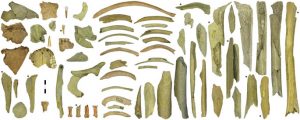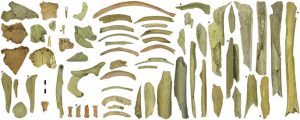Almost 150 years after the first identification of Neanderthal skeletal material, the cognitive and symbolic abilities of these populations remain a subject of intense debate. We present 99 new Neanderthal remains from the Troisième caverne of Goyet (Belgium) dated to 40,500–45,500 calBP. The remains were identified through a multidisciplinary study that combines morphometrics, taphonomy, stable isotopes, radiocarbon dating and genetic analyses. The Goyet Neanderthal bones show distinctive anthropogenic modifications, which provides clear evidence for butchery activities as well as four bones having been used for retouching stone tools. In addition to being the first site to have yielded multiple Neanderthal bones used as retouchers, Goyet not only provides the first unambiguous evidence of Neanderthal cannibalism in Northern Europe, but also highlights considerable diversity in mortuary behavior among the region’s late Neanderthal population in the period immediately preceding their disappearance.
Read more at http://www.nature.com/articles/srep29005


